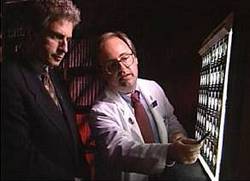The Roller Coaster Chronicles: A new plan to halt the assault

U-M’s Dr. Mark Kaminski co-developed one of the RIT drugs right here in Ann Arbor! On Dateline in 1998, he explained RIT to Robert Bazell, saying, “These antibodies are like guided missiles that can recognize exactly where the tumor cells are." | photo from NBC
Readers: The events in these installments, the condensed version of my book, occurred in 2002. To catch up from the beginning, these chronicles start here.
When my body had started its rebellion, I’d learned that chemo generally slowed the disease but that sooner or later it would return and require stronger drugs after each remission period. I’d never completed treatment with either of the two types of chemo I’d tried, much less had a remission period, so it was highly unlikely that another chemo would work any better than the first two. My options were dwindling as fast as my lymphocytes were multiplying.
I also knew that the median time from diagnosis to death was eight years, and I was terrified that lymphoma was fast-tracking me to the short side of the median. If anything was going to stop the disease, it would have to attack differently than the way chemotherapy does. Fortunately for me, while my hair was departing my head and I was vacationing in Hotel Hell, the FDA approved a new treatment that does attack differently: radioimmunotherapy (RIT). Hopefully, it would halt the assault.
Unlike chemotherapy, which can't tell the difference between healthy and malignant cells, RIT specifically targets diseased cells and mostly spares the healthy ones. That means far fewer miserable, even life-threatening, side effects. Also unlike chemotherapy, which requires months of treatment, RIT is given in two doses a week apart. Best of all, years of clinical trials showed that it produced far better outcomes than chemotherapy.
RIT combines man-made antibodies, which bind to a specific target on the lymphoma cells and then signal the immune system to destroy them, with radioactive isotopes (molecules) which then —for a dual-action and extra lethal effect — emit a burst of radiation directly to the tumor. Essentially, RIT acts like a guided missile, precisely targeting malignant cells. Chemotherapy, on the other hand, acts like buckshot, spraying everything in hopes of hitting the target. Obviously buckshot missed my targets by a mile.
And guess who helped develop RIT? My very own doctor - Mark Kaminski! Right here in Ann Arbor! But there was a glitch. Dr. Kaminski and Dr. Richard Wahl, who is now head of Nuclear Medicine at Johns Hopkins, co-developed Bexxar, an RIT treatment which was, at the time, under FDA review. In other words, I couldn't get it. However, there was another RIT treatment that had just been approved: Zevalin, whose development had begun three years after Dr. Kaminski and Dr. Wahl used Bexxar in their first clinical trials in 1990. Given the time line, I'll never understand why Zevalin was approved before Bexxar, but it was, and literally in the nick of time for me.
Two days after relapse, Dr. Kaminski called. He had made all the arrangements for me to take Zevalin, but I would have to go to another hospital to get it because Michigan — believing Bexxar's approval imminent — had not become licensed to administer it. And just in case, my sister's blood should be typed in case I needed a bone marrow transplant.
Whoa. Dr. Kaminski had gone through every trial and tribulation with me. I trusted him. Subconsciously, I'd appointed him my personal savior and clung to him for dear life. Leaving him was out of the question. And a bone marrow transplant? That was my last option, and the very mention of it, only seven months into this drama, unnerved me.
After Dr. Kaminski and I said goodbye, I immediately called Alex but didn't tell him what he expected to hear. Oh no, my brain was too scrambled for that. The steroid that I was taking might as well have been industrial strength No-Doz, and mixing acute insomnia with acute chemo brain was the perfect recipe for really bad judgment, so I reacted to Dr. Kaminski's call about as well as any dazed, confused, exhausted, wide awake, blindly loyal druggie would have. I told Alex that I would wait for Bexxar's approval because if I was going to be anyone's success, I would be Dr. Kaminski's.
Alex, of course, saw the bigger picture. "How could you possibly be Dr. Kaminski's success if you refuse the very drug that might save your life?" he asked.
Finally, I saw the light and joked, "Ok, so I was just having a blonde moment."
"You don't have any blonde anymore," Alex replied with an obvious sigh of relief. I laughed and suddenly realized that my wellness was Dr. Kaminski's only concern, not who got credit for it. Hard as it was to leave him, I had no choice if I wanted the chance to live. And that I wanted very much.
Next Friday, Nov. 19: Meet Dr. Doom
Note: The two FDA-approved RIT drugs are for treatment of indolent, non-Hodgkin lymphoma, not other forms of cancer. Click here to learn more about it or to listen to, or read the transcript of, my interview with Dr. Kaminski.
Betsy de Parry is the author of The Roller Coaster Chronicles and host of a series of webcasts about cancer. Find her on Facebook or Twitter or email her.

